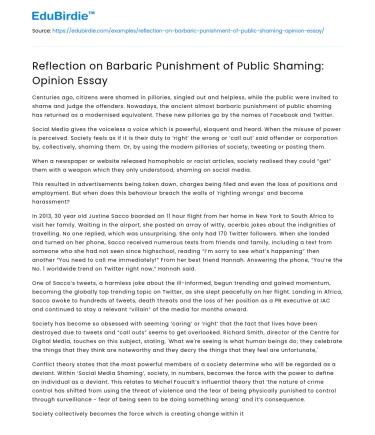Centuries ago, citizens were shamed in pillories, singled out and helpless, while the public were invited to shame and judge the offenders. Nowadays, the ancient almost barbaric punishment of public shaming has returned as a modernised equivalent. These new pillories go by the names of Facebook and Twitter.
Social Media gives the voiceless a voice which is powerful, eloquent and heard. When the misuse of power is perceived. Society feels as if it is their duty to ‘right’ the wrong or ‘call out’ said offender or corporation by, collectively, shaming them. Or, by using the modern pillories of society, tweeting or posting them.
Save your time!
We can take care of your essay
- Proper editing and formatting
- Free revision, title page, and bibliography
- Flexible prices and money-back guarantee
When a newspaper or website released homophobic or racist articles, society realised they could “get” them with a weapon which they only understood, shaming on social media.
This resulted in advertisements being taken down, charges being filed and even the loss of positions and employment. But when does this behaviour breach the walls of ‘righting wrongs’ and become harassment?
In 2013, 30 year old Justine Sacco boarded an 11 hour flight from her home in New York to South Africa to visit her family. Waiting in the airport, she posted an array of witty, acerbic jokes about the indignities of travelling. No one replied, which was unsurprising. She only had 170 Twitter followers. When she landed and turned on her phone, Sacco received numerous texts from friends and family, including a text from someone who she had not seen since highschool, reading “I’m sorry to see what’s happening” then another “You need to call me immediately!” From her best friend Hannah. Answering the phone, “You’re the No. 1 worldwide trend on Twitter right now,” Hannah said.
One of Sacco’s tweets, a harmless joke about the ill-informed, begun trending and gained momentum, becoming the globally top trending topic on Twitter, as she slept peacefully on her flight. Landing in Africa, Sacco awoke to hundreds of tweets, death threats and the loss of her position as a PR executive at IAC and continued to stay a relevant “villain” of the media for months onward.
Society has become so obsessed with seeming ‘caring’ or ‘right’ that the fact that lives have been destroyed due to tweets and “call outs” seems to get overlooked. Richard Smith, director of the Centre for Digital Media, touches on this subject, stating, 'What we're seeing is what human beings do; they celebrate the things that they think are noteworthy and they decry the things that they feel are unfortunate,'
Conflict theory states that the most powerful members of a society determine who will be regarded as a deviant. Within ‘Social Media Shaming’, society, in numbers, becomes the force with the power to define an individual as a deviant. This relates to Michel Foucalt’s influential theory that ‘the nature of crime control has shifted from using the threat of violence and the fear of being physically punished to control through surveillance - fear of being seen to be doing something wrong’ and it’s consequence.
Society collectively becomes the force which is creating change within itself. Using shame as a force to control and induce the fear of public humiliation.
The creative aims to raise awareness and discussion on the topic ‘Call out culture’ and give insight into the factors apparent when online shaming is evident such as it’s effects and consequences i.e job loss, charges filed, disruption of social relationships
This is achieved with the use of 3D collaging, including hand-drawn elements along with photos and screenprints of tweets which created controversy at the time they were posted. The posters featured within the piece are of influential and inspiring human beings, depicted in the style of Shepard Fairey’s iconic 2008, HOPE poster. The tweets placed upon these posters represent the “call outs” posted by society, in attempt to diminish, judge and “get” them.
A social group can be characterised by noting the frequency, they ‘call one another out’, implies a frivolous nature to their culture and minimises the other aspects it might have. On October 20th, 2019, ex US president Barack Obama spoke to the media about call out culture and it’s relevancy,
“Among certain young people, and this is accelerated by social media, there is some sense sometimes that the way of me making change, is to be as judgemental as possible about other people” He stated.
Twitter is very much an example of running on a concept of a marketplace of ideas where attention inevitably becomes the currency. Just like within a traditional market where quality is not really of immediate concern, instead people do what gets them more currency, more capital. Call outs are an exchange of social capital.
The intense fear of humiliation pushes social media users to, instead of defending those like Justine Sacco, comply with the majority to avoid the backlash. This shame acts as a forced used to control society via the media.
Those who are doing the “calling out” view it as an act of social justice. When ‘powerful’ people are perceived to misuse their power. Society “gets” them collectively. Realistically, it is society that holds this power. The unrestrained power to ruin lives, accessible by any social media users’ fingertips leads them to believe that by publicly ‘calling out’ those they disagree with, they are participating in the democratisation of justice when in fact, this is the opposite of democracy. This isn’t social justice, it is a cathartic alternative.






 Stuck on your essay?
Stuck on your essay?

